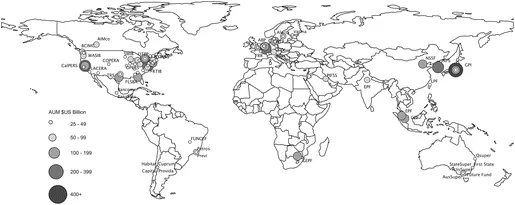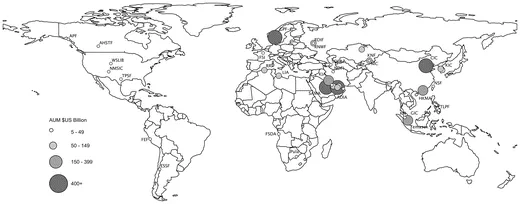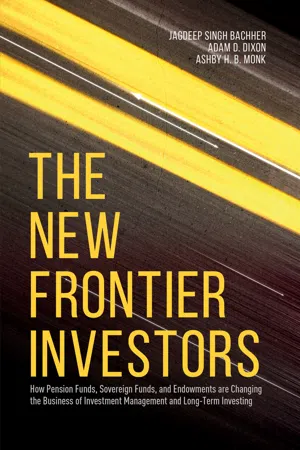In its purest form, the financial system is simply the interface between people and entities that have capital and those that require capital, under conditions of risk and uncertainty. There are temporal dimensions as well as spatial dimensions. The parties concerned are probably working to different time scales and are likely to be dispersed geographically. Financial centres and a financial services industry emerge to intermediate and match these differences. If this is done efficiently, holders of capital earn a return for providing their capital to users of capital. These users put the money to use, whether it is to expand a company, building a bridge, or invest in the health and well-being of a nation. Everyone wins. And for facilitating these flows, intermediaries are paid a fee. These fees are supposed to cover the cost of infrastructure required to move the funds around and to reward the people who identify the most efficient and promising allocation of capital.
Many asset owners are starting to question how much they are paying for this service. They are questioning having to pay fees just to access a service, regardless of performance, as if they depended on the service and not the other way around. Indeed, parts of the financial services industry seem to have forgotten that it is the asset owners that provide the capital that sustains their business model. This isn’t right. If the purpose of the financial system is forgotten, it is ultimately unsustainable. Unfortunately, many asset owners have become dependent on an industry and service that, at least in some parts, has forgotten who works for whom. The dependency that has arisen has a number of explanations, from regulatory and political constraints to the availability of skilled workers and a lack of options. Many are dependent likewise because of where they are located: far from the markets they need to employ their capital.
In this chapter we outline the map of large beneficiary institutions, focusing on sovereign funds and public pension funds, and the functional and spatial structure of asset ownership and asset management. In our view, these asset owners, as well as endowments, represent a critical base of our capitalist system; the source from which investment capital ultimately begins its path to productive capital. Here, we note that external delegation dominates convention. We then provide a conceptual model of frontier places, as a means of clarifying the relationship between asset owners in such locations and international financial centres (IFCs). The final section concludes.
Pension Fund Capitalism
In the twentieth century, the accumulation and pooling of wealth was a consequence of what could be described as pension fund capitalism. This is primarily a developed-world phenomenon, whereby Anglo-American countries and others such as Finland, Switzerland, Japan and the Netherlands made prefunded pensions, both public and private, important components of their respective pension systems. With successive pension reforms driving the growth of capitalized pension arrangements in other advanced economies (e.g. Germany) and the growth of pension savings in middle income economies, pension assets continue to grow in size and in geographic origin.1
At the end of 2014, global pension assets in the seventeen largest pension markets stood at $36,023 billion, according to data from the 2014 P&I/Towers Watson World 300. While, collectively, retirement-income organizations represent a major component of global financial markets, there are a number of institutions that, individually, control significant amounts of financial assets, which places them apart from smaller pools of capital in their ability to innovate as organizations and confront asymmetric power relationships in the investment management industry.
Figure
1.1 shows the largest retirement-income organizations with assets greater than $25 billion.
2 The majority shown are public employee pension plans, and thus government sponsored, that provide guaranteed income streams to their beneficiaries at retirement. There are, however, single-employer corporate sponsored pension funds and multiemployer industry funds. The latter are common in the Netherlands and other continental European countries. Many of the single-employer funds are associated with former state-owned enterprises and/or monopoly utilities, such as the BT Group and the Electricity Supply Pension in the United Kingdom, or legacy manufacturing firms, such as General Motors and Ford, in the United States. The General Motors pension fund, for example, is a separate asset management company located in New York. Included also are large pension reserve funds such as the French
Fonds de réserve pour la retraite and the Australian Future Fund, the latter of which was formed to cover the government’s liabilities for promised public sector pensions. Where there is a concentration of funds in a particular region, labels are not provided or only the largest fund is labelled (e.g. Tokyo).
As expected, large funds are mainly present in countries with a history of prefunded occupational pensions. In Europe, the largest pension funds are in the Netherlands, Denmark and the UK. In North America, large pension funds are located in population centres of the US Northeast and Midwest; Ontario, Canada; and several US public employee funds in places such as California, Florida, Texas and the Pacific Northwest. The largest pension fund in the world is the Government Pension Investment Fund of Japan, which manages roughly $1.4 trillion in reserve funds of the Employees’ Pension Insurance and the National Pension. There are also other large pension funds based in Tokyo, such as the Local Government Officials pension fund and the Pension Fund Association, which is a multiemployer pension fund. Elsewhere in the Asia region are the large provident funds of Singapore and Malaysia, and notably, the National Pension Service of Korea, which has just over $300 billion in assets under management.
In using a cutoff of $25 billion to simplify the map and highlight the largest pension funds, many smaller public sector pension funds across the US are excluded, and, more importantly, the concentration (and visual overlap) of smaller pension funds in particular cities. As a result, some of the largest pension fund markets in terms of assets to gross domestic product (GDP) that we have not already mentioned are understated. For example, with compulsory pension savings in Chile, there is a large asset management industry in Santiago. This is likewise the case for Australia where compulsory pension savings feeds a fund management industry centred in Sydney and Melbourne.
Although the spatial structure of large retirement-income organizations is dispersed, albeit across predominantly high-income, industrialized countries, it is important to emphasize that for the majority of these organizations asset management is delegated to for-profit private sector asset managers, most of whom are located in international or regional financial centres. Two factors drive this. First, local markets are too small and provide limited opportunities for diversification. The local market can be defined as the national economy, as in the case of the Netherlands or Australia, where the ratio of pension assets to GDP in 2013 was 166 per cent and 103 per cent respectively, or a regional economy, as in the case of Colorado Public Employees Retirement Association.3 Second, many funds are located in areas where the local market for specialized financial services is limited. We come back to the significance of this later in this chapter.
The main task of the pension plan board of directors is, in most cases, deciding on asset allocation based on risk-return targets and the selection of external asset managers (usually with the help of external pension consultants). Mandates are either given to a range of managers depending on asset class (extensive delegation), or to a smaller set of asset managers (intensive delegation).4 In either case, contractual arrangements vary over time but are generally contingent on short-term performance metrics, such as exceeding a particular market benchmark (e.g. the S&P 500).
Few retirement-income organizations manage assets internally. Where more conventional organizations do manage some of their assets internally, they are most likely to manage highly rated fixed-income securities, such as US Treasuries, or blue chip equities. In either of these cases, the decision to manage assets internally is contingent on whether there is sufficient scale to do so. Yet, what is sufficient scale is an empirical issue. The reason for our using a cutoff of $25 billion is that, in our experience, the pension funds that even consider bringing asset management back into the organization generally have assets in excess of this amount. In any case, pension funds that manage assets internally are still unusual. But, this is changing. And those that do, such as in Canada, manage a range of assets, from public equities to real estate and infrastructure.
Sovereign Fund Capitalism
If pension fund capitalism characterized wealth accumulation and capital pooling in the second half of the twentieth century, nowadays we see accumulation and pooling of wealth by additional means, and in a larger set of countries and regions. Notwithstanding the oil price shocks of the 1970s, commodity prices in general over the past decade reached historic highs, driven by rapid economic growth, particularly in Asia and other emerging market economies, and by an insatiable thirst for commodities in the rich world. For those controlling the rents from these resources, whether public or private, the past decade has been a period of massive wealth accumulation. Another source of wealth accumulation has come from current account imbalances in the global economy. Deficit countries, particularly the US, have amassed significant liabilities vis-à-vis surplus countries—namely China.
While much of the wealth accumulation from commodity production or the rebalancing of global economic activity has accrued to private hands, a large portion has also accrued to those governments that control commodity rents, the central banks that accumulate massive foreign exchange reserves, and governments that maintain consistently strong budget surpluses. To be sure, commodity exporters such as Saudi Arabia or export-led entrepôt economies such as Singapore have been accumulating wealth in these ways for decades, and have piled it directly back into global markets (and their own). Yet in the past decade, the growth in wealth accruing to states (or states hoarding wealth) has become a larger phenomenon, reaching more and more countries, and specifically emerging and developing economies. If the current form of global capitalism is one marked by financialization, the rapid growth of government-owned investment funds suggests recognition on the part of states of a world that favours holders of financial assets. As such, sovereign wealth funds (SWFs) are a mechanism by which the state can directly access global financial markets, thus providing a certain, if relative, financial influence in the international political economy.
On our count there are at least 60 sovereign funds in operation around the world, with about $5 trillion in assets under management. Figure
1.2 identifies SWFs with at least $5 billion under management. The figures are based on best estimates using publicly available information at the end of 2011. The largest SWFs with more than $400 billion are Norway’s GPF-G, the Abu Dhabi Investment Authority and the China Investment Corporation. In the western hemisphere, the largest SWF is the Alaska Permanent Fund followed by the Texas Permanent Education Fund, which was established in 1851, making it one of, if not the oldest SWF in existence. Similar to Fig.
1.1, smaller funds are not shown. This is particularly the case for the Africa region, where there is a growing number of SWFs in operation or in the planning stages.
What is interesting about this phase of state wealth accrual is that some states are establishing distinct institutional investment organizations charged with managing and investing the country’s accumulated wealth in financial markets, as distinct from an entry in the treasury’s or central bank’s balance sheet. In that respect, organizations are given latitude in executing a mandate set by the government as an independent financial institution. The more sophisticated organizations, such as Singapore’s Government Investment Corporation, appear to compete, at least in terms of long-term performance, with the world’s largest and most competitive asset managers. Like other large beneficiary asset owners, however, most SWFs delegate asset management to for-profit asset management providers in the world’s largest IFCs or large regional financial centres. Again, this is largely a function of either the local economy being too small and limited in terms of diversification, and/or the lack of local asset management capabilities.
The implication of the predominance of the delegation model by large beneficiary institutions is that responsibility for putting funds to work in the market is left to external private agents. As such, just as a principal-agent relationship exists between the asset owner and the managers of firms—an issue of corporate governance—there is an overarching principal–agent relationship between the asset owner and the asset managers. As with any such relationship, the interests between the two parties are not always symmetrical. Asset owners may use incentives to manage principal-agent conflicts, as implied above, which largely come in the form of contracts whose continuation depends on surplus performance against predetermined benchmarks. Some portfolio managers are, however, adept at gaming institutional investors on performance fees. Indeed, separating out skilled managers from unskilled managers borders on the impossible with current compensation mechanisms; instituting clawback provisions or postponing bonuses is thus likewise ineffective.5 Accordingly, fees paid by asset owners are often excessive.
While indiv...




